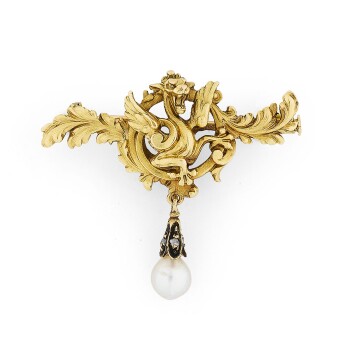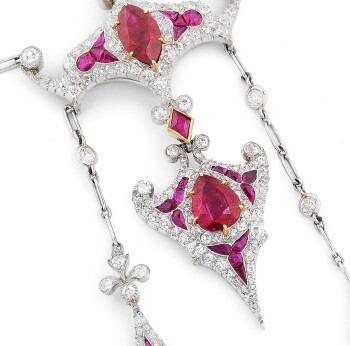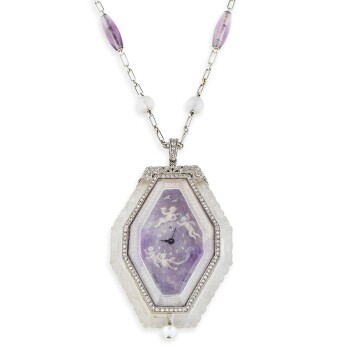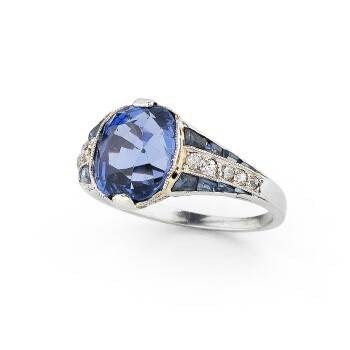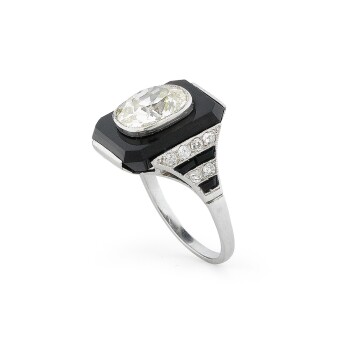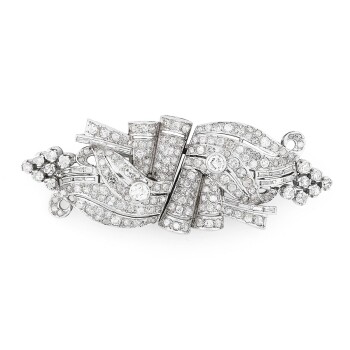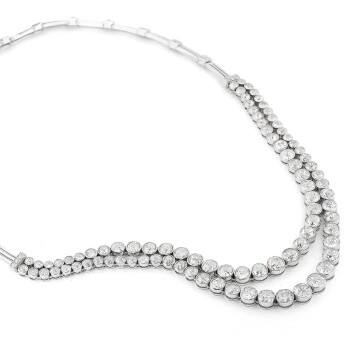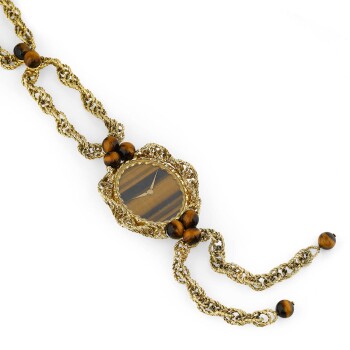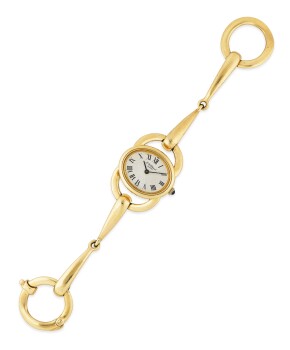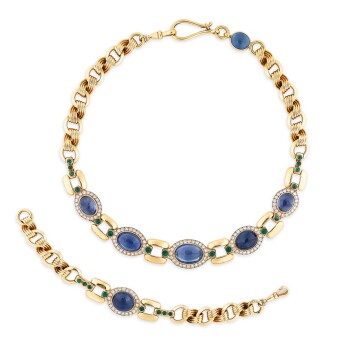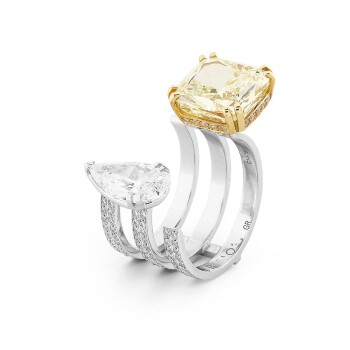T his spring, our Paris Fine Jewels sale will celebrate the elegance of the Belle Époque and Art Deco. We will be presenting two standout pieces, beautiful examples of French Jewellery, made between 1900 and 1920. To begin with, a beautiful necklace from the house of Mellerio, in its original case. Dated from around 1900, this necklace of Négligé design, set with rubies and diamonds, certainly has held a place of honor in the Jewellery collection of its original owner.
The rounded lines inspired by nature, of the Art Nouveau movement are followed by the geometry and rigor of Art Deco. The exceptional old-mine cut diamonds and onyx brooch from the house of Boivin that we are presenting today is an early example of this style. Crafted around 1910, its avant-garde geometric lines announce the Art Deco movement that would begin in the following decade.
Featured Highlights
View Lot
Click on the red dots to read details of this ring and the history of Repossi

- White Diamond
Pear-shaped diamond weighing 2.09 carats, accompanied by a GIA report no. 5141564143, dated 03 April 2012, stating that the diamond measuring 12.77 x 7.12 x 3.81mm, weighing 2.09 carats is G Colour, VVS2 Clarity.
- History of Repossi I
Repossi, the famous Turin jewelry house, was founded in the 1940s by Costantino Repossi.
From the very beginning, Repossi's creations stood out for their combination of excellent savoir-faire and strong lines, influenced by Constantino’s studies in industrial design.
Taken over by Alberto Repossi in the 1970s, the company rapidly gained recognition to become a major name in international jewellery.
- Fancy Yellow Diamond
Cushion-shaped Fancy Yellow diamond weighing 7.19 carats, accompanied by GIA report no. 5131020724, dated 04 February 2012, stating that the diamond weighing 7.19 carats, measuring 11.22 x 10.43 x 6.69mm is Natural, Fancy Yellow Colour, VVS1 Clarity.
- History of Repossi II
It is now Gaia, Alberto's daughter, who has directed the creation of Repossi since 2007.
Her creations with their pure lines have all been very quickly successful, like her 'Berbère' line launched in 2011. In 2014, Gaia presented her new collection built around a new technique: the Serti sur Vide. A perfect representation of the minimalist and architectural style of Gaia Repossi, it revolutionized the great jewellery classics.
Set on an invisible mount, the stones appear to float above the skin. The important ring that we are presenting in our spring sale is a perfect example of Repossi’s technique of Serti sur Vide. The two diamonds (weighing 2.09 and 7.19 carats respectively) mounted on either side of an open ring, give an impression of ethereal gracefulness, allowing the light to enhance the beauty of these two exceptional stones.
- Mounting
Ring partially signed Repossi, numbered, French assay mark for 18 carat gold, maker's mark.
Jewels by the Decade
- 19th Century
- 1900s
- 1910s
- 1920s
- 1930s
- 1940s
- 1950s
- 1960s
- 1970s
- 1980s
- 1990s
- 2010s
-
 Wièse | Broche or et perle | Gold and pearl broochDragons and chimeras were very popular motifs at the end of the 19th century and these motifs are frequently found in the jewellery of this period.
Wièse | Broche or et perle | Gold and pearl broochDragons and chimeras were very popular motifs at the end of the 19th century and these motifs are frequently found in the jewellery of this period.
View Lot -
 Mellerio dits Meller | Collier rubis et diamants | Ruby and diamond necklaceThe Negligé necklace, recognizable by the casual nature of its pendants of varying lengths was the perfect complement to the luxurious chiffon gowns that were considered very fashionable at the end of the 19th century.
Mellerio dits Meller | Collier rubis et diamants | Ruby and diamond necklaceThe Negligé necklace, recognizable by the casual nature of its pendants of varying lengths was the perfect complement to the luxurious chiffon gowns that were considered very fashionable at the end of the 19th century.
View Lot -
 Lacloche Frères | Sautoir-montre cristal de roche, émail, améthystes et diamants | Rock crystal, enamel, amethyst and diamond sautoir-watchAmong the novelties heralded by the Belle Époque was that of wearing a watch in the guise of a pendant, suspended on the end of a necklace. These ‘Sautoir-watches’ were a specialty of Lacloche Frères who employed miniaturists such as Fernand Paillet to create the exquisitely painted dials.
Lacloche Frères | Sautoir-montre cristal de roche, émail, améthystes et diamants | Rock crystal, enamel, amethyst and diamond sautoir-watchAmong the novelties heralded by the Belle Époque was that of wearing a watch in the guise of a pendant, suspended on the end of a necklace. These ‘Sautoir-watches’ were a specialty of Lacloche Frères who employed miniaturists such as Fernand Paillet to create the exquisitely painted dials.
View Lot -
 Bague saphirs et diamants | Sapphire and diamond ringAs we move fully into the Art Deco period we find the calibré-cut stones and platinum settings, that are very characteristic of the jewellery made during the 1920s.
Bague saphirs et diamants | Sapphire and diamond ringAs we move fully into the Art Deco period we find the calibré-cut stones and platinum settings, that are very characteristic of the jewellery made during the 1920s.
View Lot -
 Bague onyx et diamant | Onyx and diamond ringIn all its purity, black and white was definitely the chromatic rule for creations of the 1930s. In line with this sentiment, onyx, diamonds and rock crystals were extensively used.
Bague onyx et diamant | Onyx and diamond ringIn all its purity, black and white was definitely the chromatic rule for creations of the 1930s. In line with this sentiment, onyx, diamonds and rock crystals were extensively used.
View Lot -
 Broche double-clip diamants | Diamond double clip-broochA very popular piece, the double clip-brooch offered several pieces of jewellery in one. Together, the two clips form a single imposing and remarkable brooch. Separated they could be used as a stylish way to adorn the lapels of a jacket.
Broche double-clip diamants | Diamond double clip-broochA very popular piece, the double clip-brooch offered several pieces of jewellery in one. Together, the two clips form a single imposing and remarkable brooch. Separated they could be used as a stylish way to adorn the lapels of a jacket.
View Lot -
 Collier diamants | Diamond necklaceNecklaces with multiple rows of diamonds, often embellished with stylized knot designs, were another style frequently worn during this decade.
Collier diamants | Diamond necklaceNecklaces with multiple rows of diamonds, often embellished with stylized knot designs, were another style frequently worn during this decade.
View Lot -
Van Cleef & Arpels | Pochette du soir or | Gold evening clutchOf rectangular yellow gold basket weave design, opening to reveal a mirror, measuring approximately 175 x 100 x 50mm, signed Van Cleef & Arpels, numbered, French assay mark for 18 carat gold, maker's mark, for Van Cleef & Arpels, gross weight 371.35 grams; 1960s.
View Lot -
 Sautoir-montre quartz oeil-de-tigre | Tiger's-eye quartz watch-sautoirDuring the 1970s, there was a passion for hard stones such as tiger's-eye, malachite or lapis lazuli. As non-conformist as the period itself, Piaget was responsible for numerous original creations that stood at the crossroads of jewellery and watchmaking, incorporating these stones into groundbreaking and highly wearable pieces.
Sautoir-montre quartz oeil-de-tigre | Tiger's-eye quartz watch-sautoirDuring the 1970s, there was a passion for hard stones such as tiger's-eye, malachite or lapis lazuli. As non-conformist as the period itself, Piaget was responsible for numerous original creations that stood at the crossroads of jewellery and watchmaking, incorporating these stones into groundbreaking and highly wearable pieces.
View Lot -
 Montre bracelet de dame or | Lady's gold wristwatchIn this daring period where unabashed luxury was in style, yellow gold was the material of choice.
Montre bracelet de dame or | Lady's gold wristwatchIn this daring period where unabashed luxury was in style, yellow gold was the material of choice.
View Lot -
 Demi-parure saphirs, émeraudes et diamants | Sapphire, emerald and diamond demi-parureIn a sophisticated euphoria of color, cabochons sapphires, emeralds or amethysts were used increasingly on necklaces, bracelets or ear clips. It is the advent of joyous pieces where colours collide together quite happily.
Demi-parure saphirs, émeraudes et diamants | Sapphire, emerald and diamond demi-parureIn a sophisticated euphoria of color, cabochons sapphires, emeralds or amethysts were used increasingly on necklaces, bracelets or ear clips. It is the advent of joyous pieces where colours collide together quite happily.
View Lot -
 Repossi | Bague diamant Fancy Yellow et diamants | Fancy Yellow diamond and diamond ringContemporary creation in jewellery aspires to minimalism and lightness. The serti sur vide developed by Repossi is a perfect and elegant illustration.
Repossi | Bague diamant Fancy Yellow et diamants | Fancy Yellow diamond and diamond ringContemporary creation in jewellery aspires to minimalism and lightness. The serti sur vide developed by Repossi is a perfect and elegant illustration.
View Lot


Sterlé

Pierre Sterlé was an inspired and innovative jeweller who was also a lover of nature. Known as "the couturier of jewellery", he invented “fil d’ange”, a gold plating technique that he used in the creating of feathers for his famous bird brooches. As time went on, he gradually moved away from naturalism and his formal repertoire drew closer to that of artists Georges Braque or Jean Cocteau, both of whom he admired.
His designs also became more refined; the bird in flight is no longer clearly described but simply suggested by baguette and marquise-shaped diamonds. Created in the 1960s, the "Mirage" collection belongs to this greater abstraction, an approach where two-tone gold prevails.





